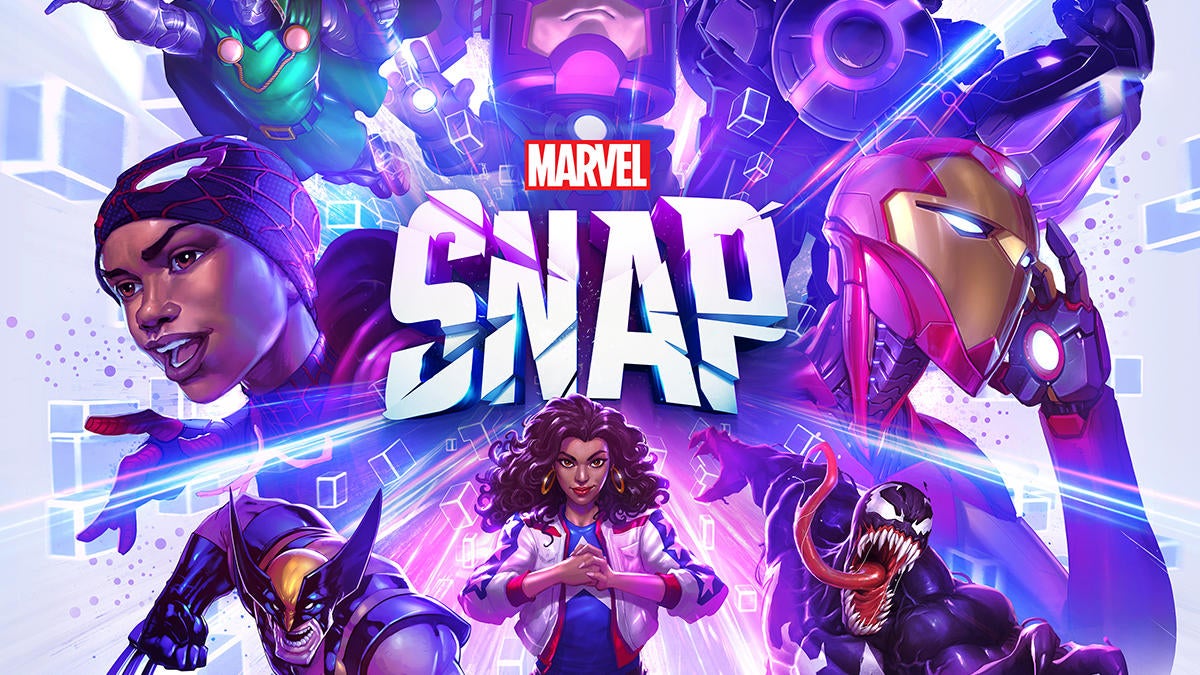Whether you’re an avid Marvel Cinematic Universe (MCU) fan, a Marvel Comics follower, or both, playing Marvel Snap can be one of your best options. This new card-battler RPG mixes the mesmerizing aesthetic of the Marvel heroes and villains into collectible cards, as well as the thrill brought by the undetermined locations you need to secure to win it all.
Snap was first released worldwide on Oct. 18, and players have been logging in en masse. The team behind the game announced that they had made $1 million in a week. As the game progresses through its first official season, it will likely continue to profit.
Here’s everything you need to know about Marvel Snap, including the basics on how to play, some tips and tricks, and what to expect once the game becomes available worldwide.
How to play Marvel Snap
The game’s objective is simple: Players need to win at least two of the three locations after the final turn. You can do this by having more power points against your opponent to secure a location. This comes from your cards that have corresponding power points on them. But your overall power can go higher depending on the effects you use and the effects of the locations being revealed one by one in the first three turns.
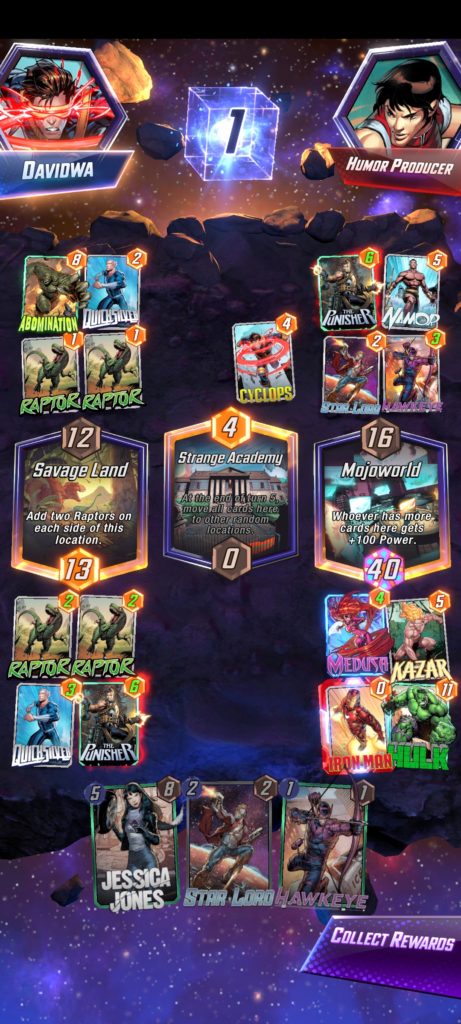
There are also cubes that you can bet on every game by clicking the mid cube on the top of the screen. This is called “Snap,” where you and your opponent can fight for two, four, or eight cubes per game, assuming both of you snapped. The winner will have all the cubes, and the loser will lose cubes based on the total number that was put into the bet. These cubes are used to rank up, with the Infinite rank being the highest.
Building your deck
Before entering a match, you must first have a deck comprised of 12 cards. Marvel Snap has faster pacing than other card games, such as Hearthstone or Legends of Runeterra, since you only play for six turns (unless a card or location effect adds an extra turn).
All cards have a cost to be played. The costs range from zero to six every turn, and the energy cap expands from one to six. Deck compositions matter in Marvel Snap, so knowing the right cards you need to put in your deck is crucial, especially knowing the cards that can synergize well.
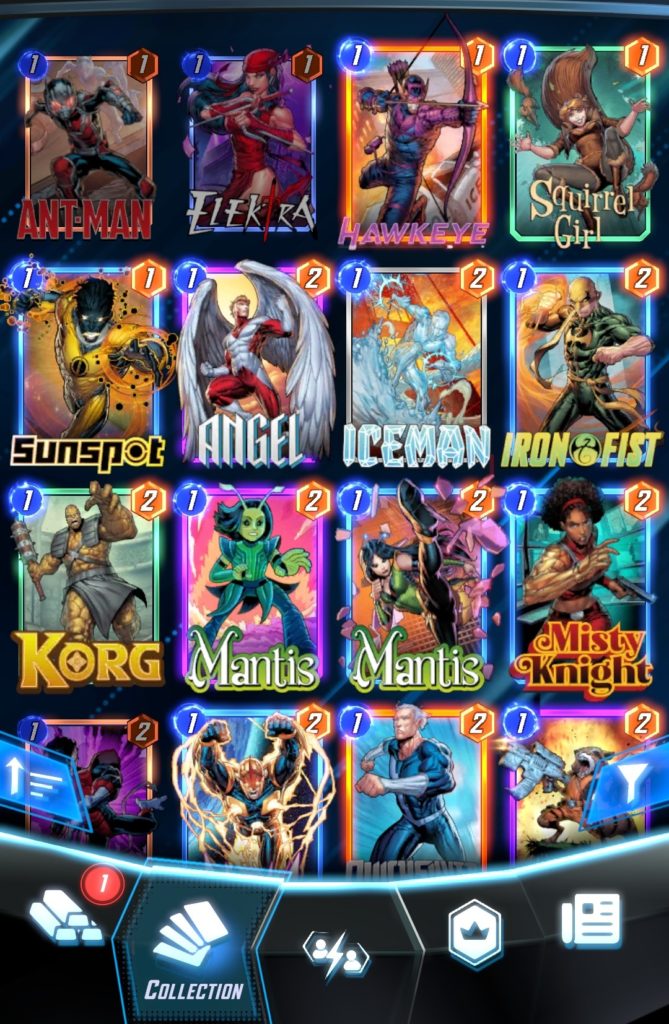
Some cards will be given to players at the beginning of the game, serving as the standard deck. But you can unlock cards along the way by increasing your collection level through upgrading cards and doing several missions.
The standard and most recommended deck structure have three or four zero-to-one costs, two to three two costs, two to three costs, and one to two each for four, five, and six costs. The zero to three costs is used to set up the early game, while most cards that cost four or above tend to have higher points that could change the game flow in the latter stages.
Knowing your deck engine
When you build your deck, don’t just put cards in that can produce a good number of points at first glance unless you want to build a vanilla deck. Knowing your deck engine is vital if you want to rise through the ranks.
A deck engine is basically how you want your deck to win a game. It is your deck’s forefront strategy, mostly centering around a certain card or two. Most deck engines use cards with effects that provide synergy along with the other pieces in a deck, providing a significant advantage to taking down the locations and winning games.
One recommended deck list with a simple yet consistent deck engine, which is beginner-friendly at the same time, is the Ongoing deck. This deck revolves around cards with Ongoing abilities, meaning these cards can provide a continuous effect as long as they are on the field.
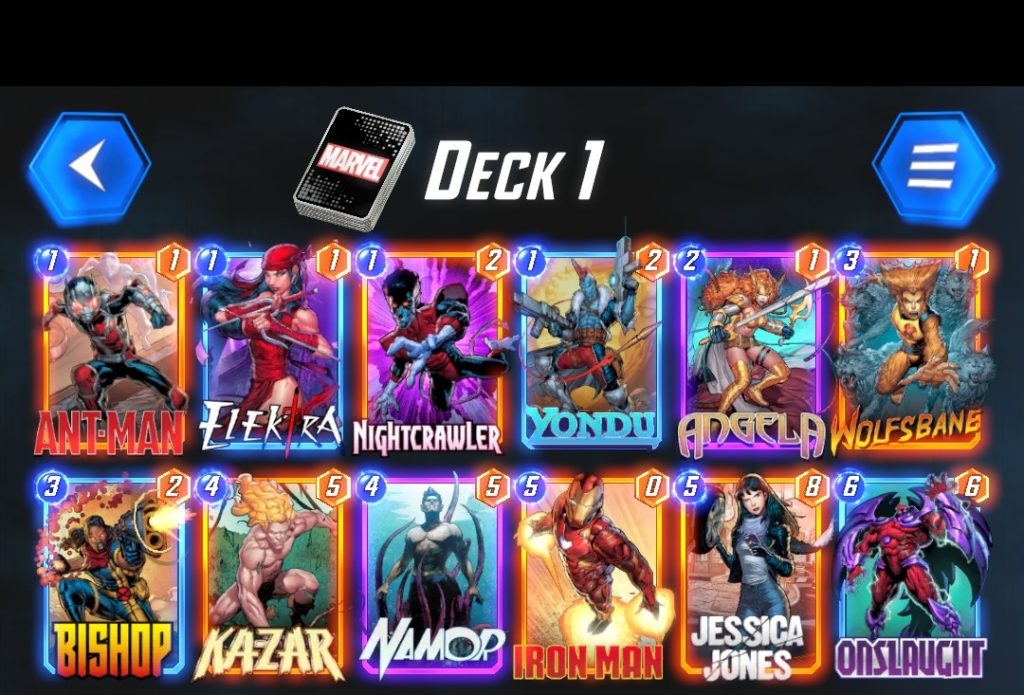
Some of the key cards in this deck include Kazar, which provides a +1 power to every one-cost card. Since this is an Ongoing effect, you can further strengthen Kazar’s granted bonus with the presence of Iron Man, who doubles the total amount of points in the location it is played. Onslaught’s ability to double any Ongoing effect can also be dangerous and can be taken advantage of with cards like Ant-Man.

Another known meta deck in the game is the Collector/Devil Dino build that focuses on adding more cards to the hand. The Collector gains +2 for each card added (not by drawing from the deck), while Devil Dino’s power is twice for each card in hand. Support cards such as Sentinel, Cable, and Moon Girl can provide the hand advantage.
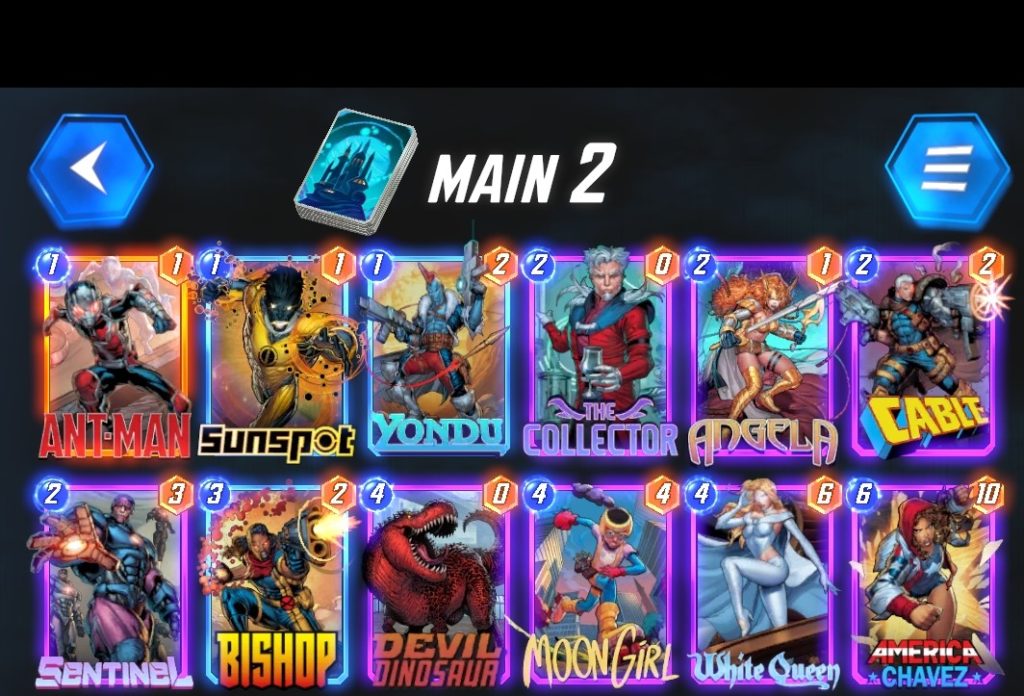
Game-changing locations
Aside from the cards, one integral factor that sets Marvel Snap apart from other card games is the locations. These locations significantly affect the game flow for you and your opponent. So it is a must that you adapt your strategy based on the location effects in each match.
One example of a location in Marvel Snap is the Cloning Vats. This location allows players to add a copy of a card played here. This is helpful to take advantage of powerful cards like Devil Dino because, usually, you can only have one copy of a card from your deck unless a card effect allows you to duplicate a certain card.
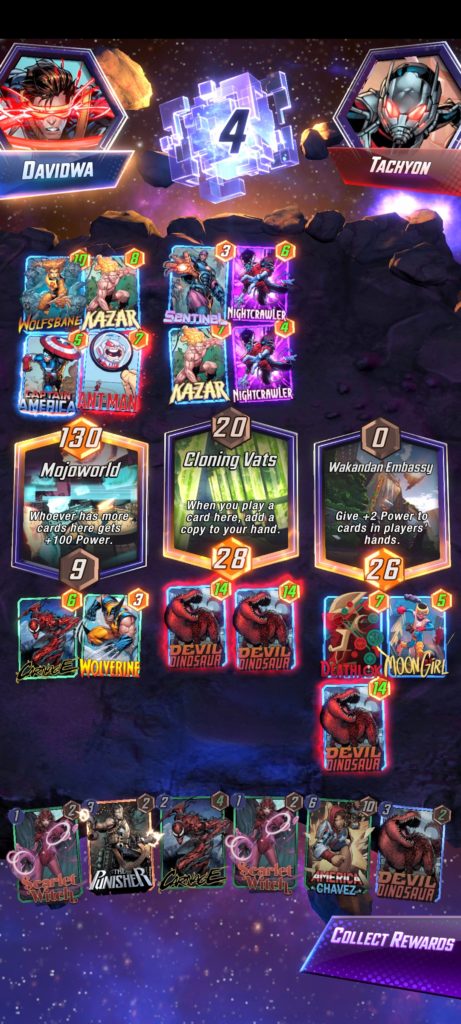
Some locations harm both players. This includes the Negative Zone, which gives -3 power to every card you play here. That is why it is best to put cards here with high power points, like America Sanchez, The Incredible Hulk, and The Infinaut. Saving space for a five or six-cost with massive power is useful during these situations.
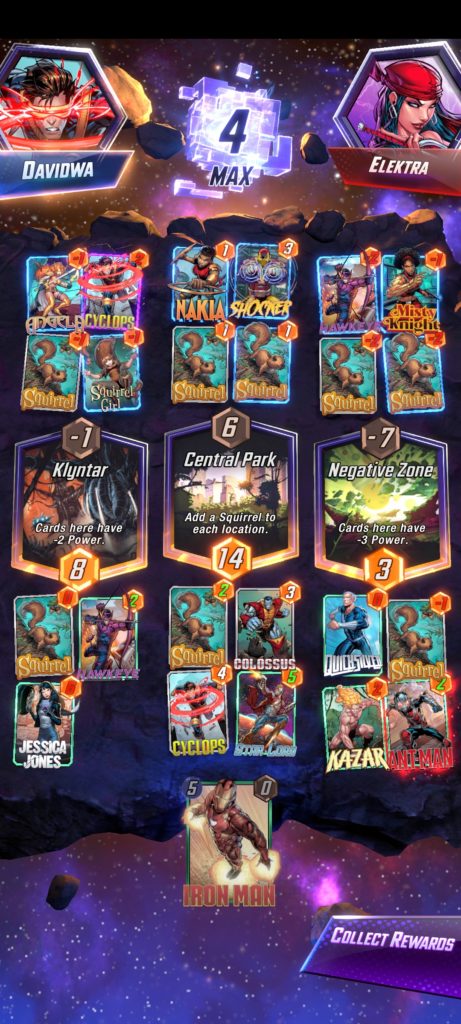
Here are the other locations currently available in Marvel Snap:
- Asgard – At the end of turn four, whoever wins here draws two cards.
- Atlantis – If you only have one card here, it has +5 Power.
- Avengers Compound – On turn five, you must play all cards here.
- Baxter Building – Whoever wins this location gets +3 Power at the others.
- Central Park – Add a Squirrel to each location.
- Cloning Vats – When you play a card here, add a copy to your hand.
- Crimson Cosmos – You can’t play one, two, and three-cost cards here.
- Daily Bugle – Get a copy of a card in your opponent’s hand.
- Danger Room – Cards played here have a 25 percent chance of being destroyed.
- Dark Dimension – Cards played here are not revealed until the game ends.
- Death’s Domain – When you play a card here, destroy it.
- District X – Replace both decks with 10 random cards.
- Dream Dimension – On turn five, cards cost one more.
- Ego – Ego takes over and plays your cards for you.
- Elysium – Cards cost one less.
- Grand Central – At the end of turn five, put a card from each player’s hand here.
- Hala – At the end of turn four, destroy all cards controlled by the player losing.
- Hellfire Club – You can’t play one-cost cards here.
- K’un-Lun – When a card moves here, give it +2 Power.
- Kamar-Taj – On Reveal effects happen twice at this location.
- Klyntar – Cards here have -2 Power.
- Knowhere – On Reveal effects do not happen at this location.
- Kyln – You can’t play cards here after turn four.
- Lechuguilla – When you play a card here, shuffle three rocks into your deck.
- Lemuria – No cards are revealed this turn.
- Limbo – There is a turn seven this game.
- Los Diablos Base – At the end of turn three, ruin a random location.
- Mindscape – At the start of turn six, swap hands.
- Miniaturized Lab – You can’t add cards on turns three, four, and five.
- Mirror Dimension – On turn four, transform into one of the other locations.
- Mojoworld – Whoever has more cards here gets +100 Power.
- Monster Island – Add a nine-Power Monster here for each player.
- Monster Metropolis – The cards with the highest Power here get +3 Power.
- Muir Island – After each turn, give cards here +1 Power.
- Murderworld – At the end of turn three, destroy all cards here.
- Negative Zone – Cards here have -3 Power.
- New York – On turn six, you can move cards to this location.
- Nidavellir – Cards here have +5 Power.
- Nova Roma – Draw a card.
- Olympia – Draw two cards
- Onslaught’s Citadel – Ongoing effects here are doubled.
- Ruins – Does not have an effect.
- Sakaar – Put a card from each player’s hand here.
- Sanctum Sanctorum – You can’t play cards here.
- Savage Land – Add two Raptors on each side of this location.
- Shadowland – Add a Ninja to each side with -2 Power.
- Sinister London – When you play a card here, add a copy to another location.
- Sokovia – Discard a card from each player’s hand.
- Stark Tower – At the end of turn five, give all cards here +2 Power.
- Starlight Citadel – After turn four, swap the position of each location.
- Strange Academy – At the end of turn five, move all cards here to other random locations.
- Subterranea – Shuffle five rocks into each deck.
- The Bar With No Name – Whoever has the least Power here wins.
- The Big House – Four, five, and six-cost cards can’t be played here.
- The Hub – Add a random card to each player’s hand.
- The Ice Box – Give a card in each player’s hand +1 Cost.
- The Space Throne – Only one card can be here for each player.
- The Superflow – If you have no cards here, +1 energy each turn.
- The Vault – On turn six, you can’t play cards here.
- Tinkerer’s Workshop – +1 Energy this turn.
- Titan – Six-cost cards cost one less.
- Transia – Shuffle the locations.
- Wakanda – You can’t destroy cards here.
- Wakandan Embassy – Give +2 Power to cards in players’ hands.
- Washington D.C. – Cards here with no abilities have +3 Power.
- Weirdworld – Both players draw from their opponent’s decks.
- Westview – Turns into a new location on turn four.
- Worldship – Destroy the other locations.
- X-Mansion – At the end of turn three, add a random card for each player.
- Xandar – Cards here have +1 Power.
Other Marvel Snap tips and tricks
Aside from knowing how to bolster your side of the field, it is a must to always watch out for what your opponent plays. As mentioned, there are only 12 cards in a single deck, so it would not be hard to know what your opponent is up to, especially in determining their deck engine. This can also help you see if you may have the upper hand to do a snap, which could catch them off guard.
Exploring other deck engine options can also help you find the playstyle that fits you best. This is beneficial for some card-specific missions too, wherein you need to play or win games with a specified card to gain resources that you can use to expand your Collection Level. Expanding your Collection Level will then allow you to unlock more powerful cards and get other rarer art variants of your existing cards.

